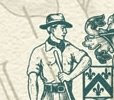My Gift to the Consulting Community
We tried a new metaphor in discussing ideas. I found it helpful, so I open-source it to the world. If you come across it in a consultant's presentation, it's all down to me, your hear? Me!
"Will this idea fly?" said a colleague. "Interesting, I thought, let's apply the four forces in aviation."
Thrust is the effort we're putting in
Weight is the cost of the people involved
Lift will be the sales income, but in a start-up phase it's products, prototypes, maybe just enthusiasm
Drag will be barriers, distractions, doing the wrong thing, pessimism
The way I'd use this metaphor is to say that we can make a project "fly" by increasing thrust or lift, or decreasing weight or drag. If everyone's working for free for ever, then weight is zero so when there's some lift it will fly.
At other times, I'd discuss progress in terms of what was providing lift, what was providing drag, and ask ourselves it we can increase one or decrease the other.
It's a nice metaphor, because everyone can relate both to the image of soaring into the air, and to huffing and puffing along without take-off.
By the way, I designed the image on an iPad using Canva www.canva.com - worth checking out.


